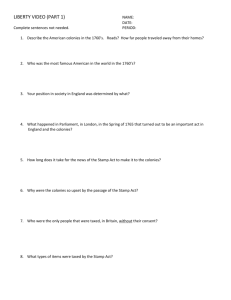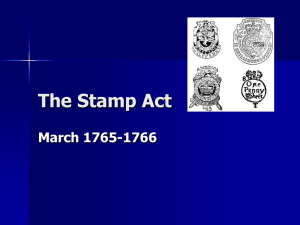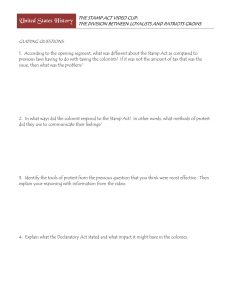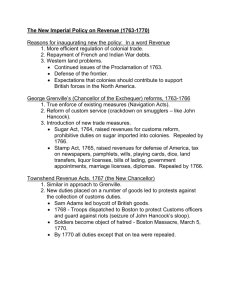Stamp Act (Word Document)
advertisement
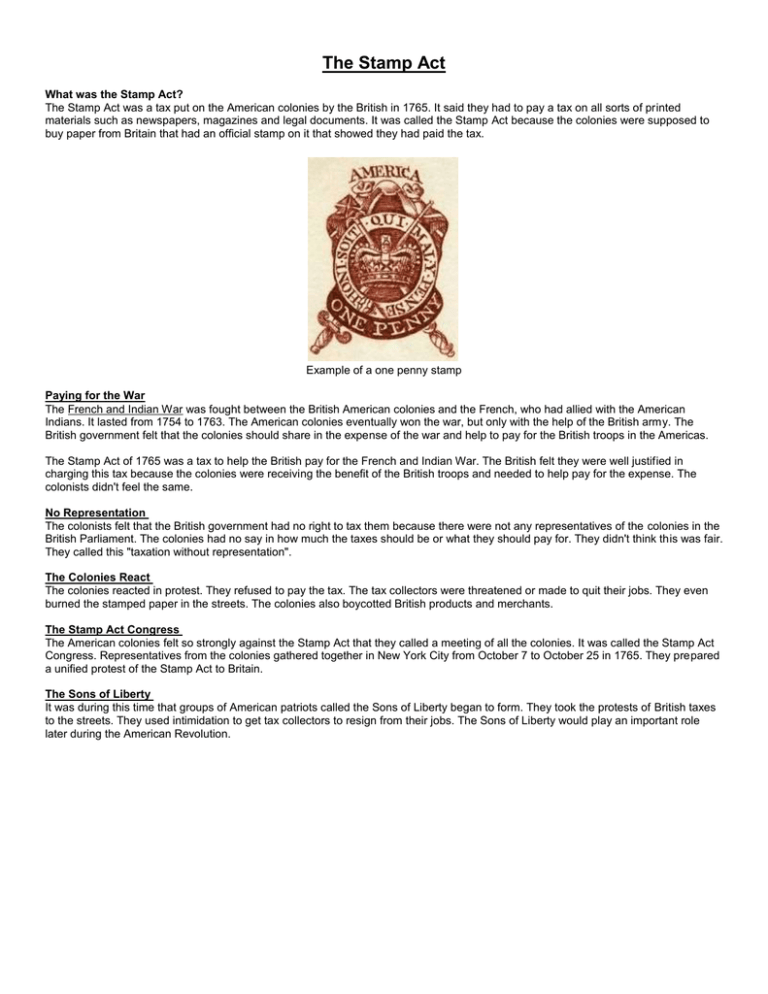
The Stamp Act What was the Stamp Act? The Stamp Act was a tax put on the American colonies by the British in 1765. It said they had to pay a tax on all sorts of printed materials such as newspapers, magazines and legal documents. It was called the Stamp Act because the colonies were supposed to buy paper from Britain that had an official stamp on it that showed they had paid the tax. Example of a one penny stamp Paying for the War The French and Indian War was fought between the British American colonies and the French, who had allied with the American Indians. It lasted from 1754 to 1763. The American colonies eventually won the war, but only with the help of the British army. The British government felt that the colonies should share in the expense of the war and help to pay for the British troops in the Americas. The Stamp Act of 1765 was a tax to help the British pay for the French and Indian War. The British felt they were well justified in charging this tax because the colonies were receiving the benefit of the British troops and needed to help pay for the expense. The colonists didn't feel the same. No Representation The colonists felt that the British government had no right to tax them because there were not any representatives of the colonies in the British Parliament. The colonies had no say in how much the taxes should be or what they should pay for. They didn't think this was fair. They called this "taxation without representation". The Colonies React The colonies reacted in protest. They refused to pay the tax. The tax collectors were threatened or made to quit their jobs. They even burned the stamped paper in the streets. The colonies also boycotted British products and merchants. The Stamp Act Congress The American colonies felt so strongly against the Stamp Act that they called a meeting of all the colonies. It was called the Stamp Act Congress. Representatives from the colonies gathered together in New York City from October 7 to October 25 in 1765. They prepared a unified protest of the Stamp Act to Britain. The Sons of Liberty It was during this time that groups of American patriots called the Sons of Liberty began to form. They took the protests of British taxes to the streets. They used intimidation to get tax collectors to resign from their jobs. The Sons of Liberty would play an important role later during the American Revolution. People burning the stamped paper The Act is Repealed Eventually, the protests of the colonies to the Stamp Act began to hurt British merchants and businesses. The Stamp Act was repealed on March 18, 1766. However, the British Parliament wanted to send a message to the colonies. The Stamp Act may not have been a good way to tax the colonies, but they still felt they had the right to tax the colonies. The same day they repealed the Stamp Act, they passed the Declaratory Act which stated that the British Parliament had the right to make laws and taxes in the colonies. More Taxes The British government didn't stop trying to tax the colonies. They continued to add taxes including a Tea Tax that would lead to the Boston Tea Party and eventually the American Revolution. Interesting Facts About the Stamp Act The taxes for the Stamp Act had to be paid for with British money. They would not take colonial paper money. John Adams, future president of the United States, wrote a series of resolutions protesting the tax. The French and Indian War was called the Seven Years War in England. The British Parliament really thought that the tax was fair. It was not their intention to oppress the colonists. The Sons of Liberty was started by Massachusetts' patriot Sam Adams.
